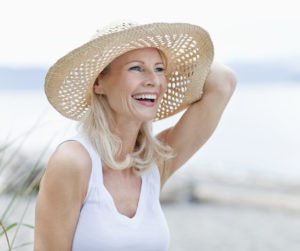 “Did you pack the sunscreen?
“Did you pack the sunscreen?
Apply sunscreen regularly.
You must wear sunscreen every day!
… And don’t forget to wear sunscreen.”
Sunscreen, sunblock, sun protection, sun exposure, sun damage… these are the watchwords we’ve all heard (and hopefully heeded) for decades. We know that our skin is incredibly vulnerable to the impact of ultraviolet (UV) rays, putting us at risk for developing skin cancers. We’re also aware that those rays speed up the aging process.
But, exactly HOW does the sun age us?
The premature aging of the skin by the sun is called photoaging and the most common indicators of this process are wrinkles and dark spots. So, what’s happening here? Well, folks, what’s happening is radiation. When ultraviolet radiation (UVR) hits the dermis layer of the skin, it damages the collagen and elastin fibers supporting skin structure, weakening them significantly and potentially altering the production of certain enzymes.
There are two types of ultraviolet rays, UVA and UVB rays, and the main difference between them is the range of each wavelength. UVA rays have a longer wavelength reaching deep into the dermis layer to mess with those fibers. UVB rays have a shorter wavelength and seem to be the force behind sunburn. In fact, the golden tan we crave is actually a result of the body trying to get enough melanin up to the epidermis to block harmful radiation. Frighteningly enough, depending on skin tone, even one or two sunburns could be enough to cause serious damage.
The Skin Cancer Foundation reports that recent studies show definitive evidence that photoaging is delayed by daily application of a broad-spectrum sunscreen, a formula addressing both UVA and UVB rays. Regular use of quality sunscreen at SPF 30 or higher can not only guard against creases and discolorations, but also improves the skin’s overall tone, texture and clarity as it shields those collagen and elastin fibers.
Robinson Facial Plastic Surgery Esthetician and Laser Practitioner Heather Davis reminds clients that UV rays stream down from the sun every day, no matter what the weather. She recommends making sunscreen application a habitual part of the daily skincare routine and answers some questions about products and procedures:
When should sunscreen be applied?
Use something every day and add more for prolonged exposure or activity outdoors. Follow the instructions on the product label. FDA guidelines are very specific and the products are labeled now with appropriate reapplication time. If listed as sweat-resistant and/or water-resistant, the formula performs for a certain period of time (usually 40-80 minutes depending on the product) and then must be reapplied. This is THE MOST poorly understood fact by the public that no matter what strength SPF your sunblock is, it needs to be re-applied every 60-90 minutes due to the fact it breaks down from the UV radiation (think of holes being poked into the “force field”.
Why choose medical-grade sunscreen over drugstore brands?
The ingredient zinc oxide tends to be more micronized in the medical-grade formulas. This being one of the most important ingredients yet can be the least cosmetically elegant. The micronization reduces the problem of a telltale “silver sheen” on the face and body. Also, medical-grade products usually contain the highest overall percentage of zinc oxide and titanium dioxide, which are the physical sunscreens. They work immediately.
What medical-grade sunscreen products does RFPS carry?
EltaMD? and Revision? Intellishade?.
Revision Intellishade is a wonderful everyday facial sunscreen with a subtle tint that balances any skin tone. The Matte formula adjusts well to oily skin and the Original formula works best on drier skin types. EltaMD sunscreens are available in formulations for a variety of skin types and usages, from sensitive skin blends to superior protection for active lifestyles.
In a pinch, when traveling and out of sunscreen, what should be considered when selecting a drugstore brand? Find the formula with the highest percentage of titanium dioxide and zinc oxide and an SPF of 30 to 50!
In addition to UVRs, the sun also emits Infrared radiation (IRA) which we feel as heat. As it turns out, scientific research indicates that IRAs cause some sun damage by releasing free radicals– unstable atoms and electrons that bind to healthy proteins, triggering oxidation and wreaking havoc on the complexion. For an extra boost of sun protection, supplement daily skincare routines with an antioxidant product containing vitamin C. As a powerful antioxidant, vitamin C helps cushion the blow, stabilizing those free radicals and slowing down the oxidation process as well as stimulating production of collagen, the skin’s natural repairing mechanism. Adding a topical antioxidant formula before sunscreen can double the anti-aging benefits!
Make an appointment with Heather for an assessment to help determine the most effective products to start an enhanced sun protection routine. Call 770-667-3090 to schedule your appointment today!



